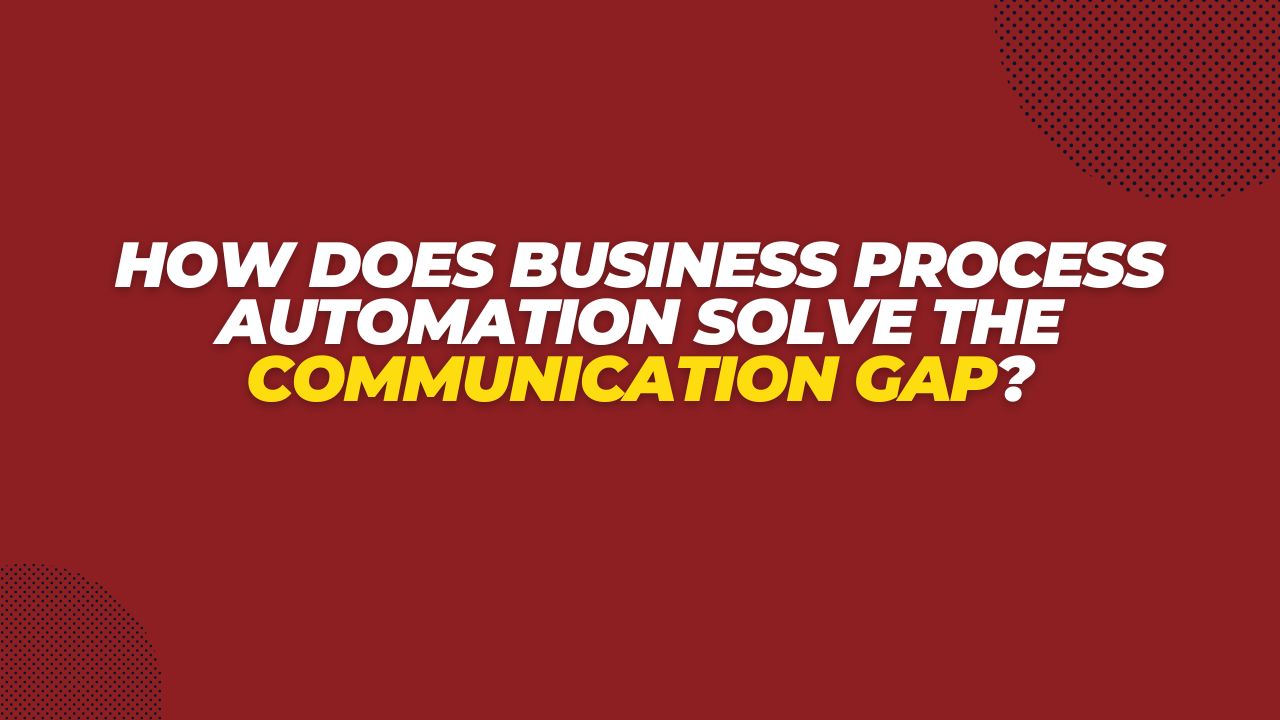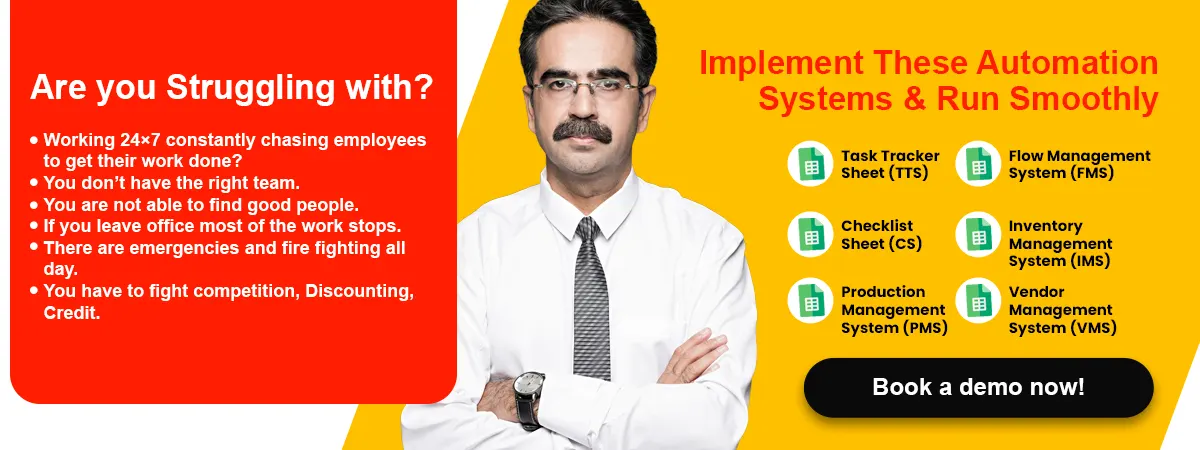by Subhadeep Chowdhury
Share

Today in the fast-paced business landscape, effective communication is paramount for success. Yet, amidst the myriad of tasks and departments within an organization, communication gaps often emerge, hindering productivity and efficiency. This is where the transformative power of business process automation (BPA) comes into play, offering a seamless solution to bridge these gaps and streamline operations.
By leveraging cutting-edge technology and intelligent workflows, BPA revolutionizes the way businesses communicate, ensuring swift transmission of information across all levels of the organization. From automating routine tasks to integrating disparate systems, BPA fosters collaboration, enhances transparency, and accelerates decision-making processes.
In this dynamic era of digital transformation, understanding how BPA can effectively bridge communication gaps is not just advantageous—it’s imperative. Join us on a journey as we delve into the intricacies of BPA and explore how it empowers businesses to thrive in an interconnected world.
Let’s keep reading this article to learn more.
Understanding Communication Gaps | How Does Business Process Automation Solve Communication Gaps
Communication gaps manifest in various forms within organizations, leading to misunderstandings, delays, errors, and inefficiencies. These gaps may arise due to:
- Information Silos: Traditional setups often see departments functioning in isolation, leading to limited interaction and information sharing. This siloed approach results in fragmented communication and a lack of holistic understanding across the organization. Without effective collaboration between departments, valuable insights may be overlooked, hindering innovation and growth.
- Manual Processes: Relying on manual processes for communication tasks exposes organizations to a myriad of risks. Human intervention introduces the potential for errors, delays, and inconsistencies, as well as misinterpretation and oversight. Moreover, manual tasks are inherently time-consuming and labor-intensive, diverting resources from more strategic initiatives. Streamlining these processes through automation not only improves accuracy and efficiency but also frees up valuable time for employees to focus on higher-value activities.
- Multiple Communication Channels: The abundance of communication channels, while offering flexibility, can also create challenges. Without a centralized platform to manage these channels, important messages may get lost or overlooked amidst the noise. Fragmentation across email, instant messaging, phone calls, and meetings can lead to confusion and inefficiency. By consolidating communication channels within a unified platform, organizations can ensure that information is easily accessible and consistently managed, enhancing collaboration and productivity.
- Poor Documentation: Inadequate documentation practices pose significant risks to organizational communication. Without clear records of decisions, changes, and progress, stakeholders may struggle to stay informed and aligned. Moreover, poor documentation hampers accountability and transparency, making it difficult to track responsibilities and resolve disputes. By implementing robust documentation processes and leveraging automation tools to capture and organize information, organizations can mitigate communication gaps and foster a culture of accountability and clarity.
Also read our article : How Workflow Efficiency Impacts Business Growth
The Role of Business Process Automation
Business process automation offers a comprehensive solution to address communication gaps by optimizing workflows, minimizing manual intervention, and fostering collaboration.
Here is how BPA can effectively bridge communication gaps:
- Streamlined Workflows: Business process automation (BPA) empowers organizations to streamline their workflows by automating repetitive tasks and standardizing communication protocols. This ensures consistency and efficiency across departments, minimizing the risk of miscommunication and errors. By mapping out workflows and automating routine interactions, businesses can optimize their processes, freeing up valuable time and resources for more strategic endeavors, ultimately driving productivity and growth.
- Centralized Communication Hub: Implementing a centralized platform for communication, such as a collaborative workspace or project management tool, fosters transparency and accessibility within an organization. By providing a single source of truth for information, documents, and discussions, team members can easily access relevant resources, reducing the likelihood of information silos and misunderstandings. This centralized approach enhances collaboration, streamlines decision-making, and promotes alignment across teams and departments, driving overall efficiency and effectiveness.
- Real-time Updates and Notifications: Automation enables organizations to deliver real-time updates and notifications to stakeholders, keeping them informed of developments, deadlines, and milestones. Whether through automated alerts or instant messaging systems, timely communication ensures that everyone stays on the same page and can respond promptly to changes. This proactive approach enhances agility, minimizes delays, and improves decision-making, ultimately driving operational excellence and customer satisfaction.
- Integration of Systems: BPA solutions facilitate seamless communication by integrating with existing systems and applications across different platforms. Whether synchronizing data between CRM and marketing automation software or connecting email and task management tools, integration reduces friction and enhances collaboration. By breaking down data silos and enabling data exchange between disparate systems, organizations can unlock valuable insights, improve efficiency, and drive innovation, ultimately gaining a competitive edge in the market.
- Workflow Optimization: BPA helps organizations optimize their workflows by analyzing processes and identifying bottlenecks or inefficiencies. Automation tools can route tasks, escalate issues, and trigger actions based on predefined rules, minimizing delays and ensuring tasks are completed in a timely manner. By streamlining workflows and eliminating manual interventions, businesses can improve productivity, reduce costs, and enhance customer satisfaction, ultimately driving sustainable growth and success.
- Documentation and Audit Trails: BPA systems provide robust documentation capabilities, capturing every interaction, decision, and change within the workflow. This comprehensive audit trail not only ensures accountability but also serves as a valuable resource for tracking progress, resolving disputes, and conducting post-mortem analyses. By maintaining accurate and detailed records, organizations can mitigate risks, comply with regulatory requirements, and continuously improve their processes, ultimately fostering a culture of transparency, trust, and excellence.
Also read: How Business Automation Helps In Error Minimization
Best Practices for Implementing BPA to Address Communication Gaps
- Assess Current Processes: Before diving into Business Process Automation (BPA), it’s crucial to conduct a comprehensive evaluation of your existing communication workflows. Identify pain points like bottlenecks, inefficiencies, and areas prone to errors. This assessment provides a clear picture of where improvements are needed, laying the groundwork for a successful BPA implementation.
- Define Clear Objectives: Establishing precise objectives and key performance indicators (KPIs) is essential for guiding your BPA journey. Whether it’s reducing response times, enhancing accuracy, or boosting productivity, clearly defined goals ensure everyone understands what success looks like and enables effective measurement of progress throughout the automation process.
- Engage Stakeholders: Collaboration is key to successful BPA implementation. Engage stakeholders from various departments and levels of the organization to gain diverse perspectives and ensure alignment with overarching business objectives. Involving stakeholders fosters buy-in, promotes transparency, and helps tailor automation solutions to meet specific needs across the organization.
- Select the Right Tools: Choosing the appropriate BPA tools is critical for seamless integration and optimal performance. Assess options based on factors such as compatibility with existing systems, scalability, user-friendliness, and vendor support. Selecting the right tools ensures that your automation solution aligns with organizational requirements and can adapt to future growth and technological advancements.
- Provide Training and Support: Transitioning to automation requires empowering employees with the necessary skills and knowledge to utilize new tools effectively. Invest in comprehensive training programs to familiarize staff with BPA technologies and their roles in the automated workflows. Additionally, ongoing support and guidance ensure that employees feel supported throughout the implementation process and beyond.
- Monitor and Iterate: Continuous monitoring and refinement are essential for maximizing the benefits of BPA. Regularly track performance metrics to gauge the effectiveness of automation efforts and identify areas for improvement. Solicit feedback from end-users to understand their experiences and make necessary adjustments to enhance usability and efficiency. Iterating on your BPA implementation allows for adaptability to evolving business needs and technological advancements, ensuring sustained success in the long run.
Also read: What are the impacts of Improper Workflow In Business?
NOTE:
In the realm of modern business operations, effective communication stands as a cornerstone for success. However, organizations often grapple with the challenge of bridging the communication gap between various departments, hindering productivity and efficiency. Here, the transformative power of business process automation (BPA) emerges as a beacon of solution. By implementing BPA solutions, firms can streamline workflows, automate routine tasks, and facilitate seamless information exchange across disparate teams. ECONSTRA, a leading business consultancy, recognizes the pivotal role of BPA in enhancing organizational communication dynamics. Through tailored BPA strategies, ECONSTRA empowers businesses to optimize their internal processes, minimize delays, and foster a collaborative environment conducive to innovation and growth. From automating email notifications to integrating communication channels, BPA not only expedites decision-making but also nurtures a culture of transparency and accountability within enterprises. With ECONSTRA’s expertise in harnessing BPA technologies, businesses can transcend communication barriers and embark on a journey towards operational excellence.
Conclusion: How Does Business Process Automation Solve Communication Gap?
As we conclude our exploration into the transformative realm of business process automation (BPA), it becomes abundantly clear that this innovative solution holds the key to bridging communication gaps within organizations.
By seamlessly integrating technology into everyday workflows, BPA not only enhances efficiency but also fosters collaboration and transparency across departments. As businesses navigate the complexities of the modern landscape, the ability to adapt and evolve becomes increasingly crucial.
BPA offers a roadmap to success, empowering organizations to streamline operations, accelerate decision-making, and ultimately, achieve their strategic objectives. As we look to the future, it’s evident that those who embrace BPA will not only survive but thrive in an ever-evolving business environment.
So let us harness the power of automation, break down communication barriers, and pave the way for a more connected and productive future.
STAY IN THE LOOP
Subscribe to our free newsletter.
Business consultant services provide the strategic insight and expertise necessary to steer your company through various challenges and opportunities. These professionals play a crucial role in helping businesses identify growth opportunities, optimize operations, and achieve long-term success. Understanding the Role of a Business Consultant A business consultant acts as an external advisor who brings a […]
In today’s competitive business landscape, companies are constantly seeking ways to reduce operational costs while maintaining or improving efficiency and customer satisfaction. Customer Relationship Management (CRM) systems have emerged as vital tools that enable businesses to achieve these goals. As a leading business consultancy, Econstra understands the importance of leveraging CRM technology to streamline operations, […]
Why Operational Costs Are Draining Your Profits? Operational costs are a critical aspect of running a successful business, but when not managed properly, they can drain your profits and stifle growth. In a competitive market, maintaining profitability requires keen oversight of expenses and strategic planning. Econstra, as a leading business consultancy, provides insights and strategies […]
In the rapidly advancing digital landscape, Artificial Intelligence (AI) tools have emerged as transformative assets for businesses. Their potential to enhance efficiency, streamline operations, and drive innovation makes them invaluable for business consultants and organizations worldwide. For business consultants in India, AI’s strategic application can be particularly advantageous in navigating a diverse and dynamic market. […]





